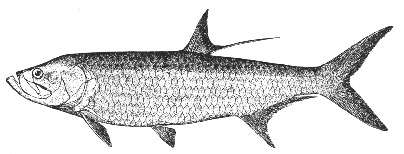Tarpon Tarpon atlanticus (Cuvier and Valenciennes) 1846
[Jordan and Evermann, 1996-1900, p. 409, fig. 177.]

Figure 39.—Tarpon (Tarpon atlanticus), New Jersey. From Goode. Drawing by H. L. Todd.
Description—
The tarpon is herring-like in general form and appearance, but it is made easily recognizable by the fact that the last ray of the dorsal fin is greatly prolonged, its free portion being as long as the fin is high or longer, and by the presence of the bony plate on the throat mentioned above (p. 85) in the characterization of the family to which it belongs. Furthermore, the anal fin of the tarpon is deeply falcate; that of all Gulf of Maine herring-fishes rhomboid in outline. The ventral fins, which are situated under or behind the dorsal fin in herrings, alewives, shad, and menhaden, are considerably in front of the dorsal fin in the tarpon, while the lower jaw of the latter projects relatively further; its scales are relatively larger; and its caudal fin is relatively wider.
Color—
Bright silvery all over, the back darker than the belly.
Size—
Tarpon grow to a length of 6 to 8 feet; the longest recorded was 8 feet 2 inches; the heaviest taken on rod and reel weighed 247 pounds.[15]
General range—
Tropical and subtropical coasts of America, from Brazil to Long Island, casually to Cape Cod, and to Nova Scotia, where it has been recorded off Isaacs Harbor and in Harrigan Cove.[16] Its chief center of abundance is in the West Indies, about Florida, and in the Gulf of Mexico.
Occurrence in the Gulf of Maine—
A specimen 5½ feet long, taken at Provincetown on July 25, 1915,[17] is the only record of the tarpon in the Gulf of Maine, which it reaches only as an accidental straggler from the south.